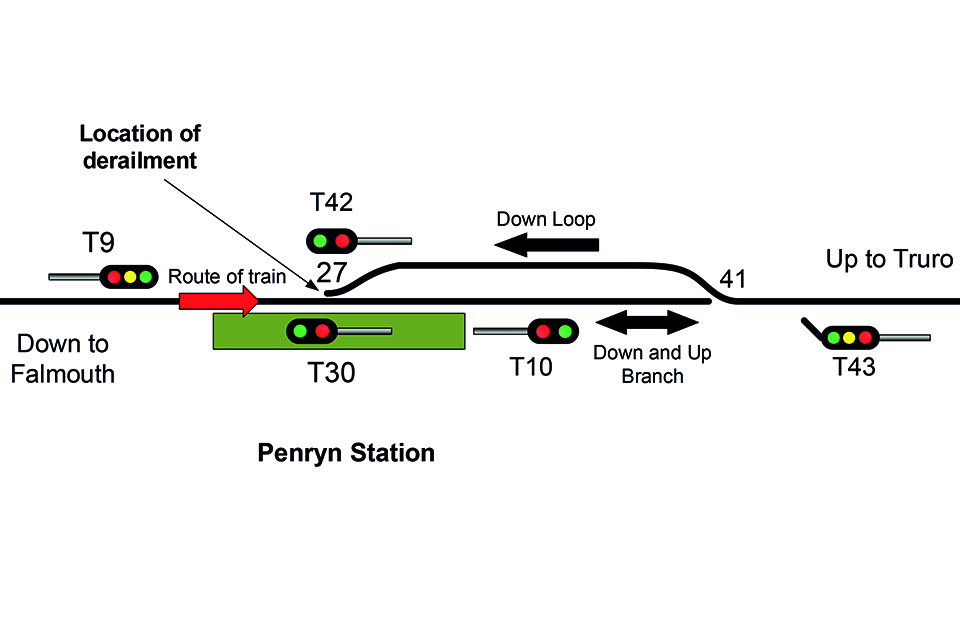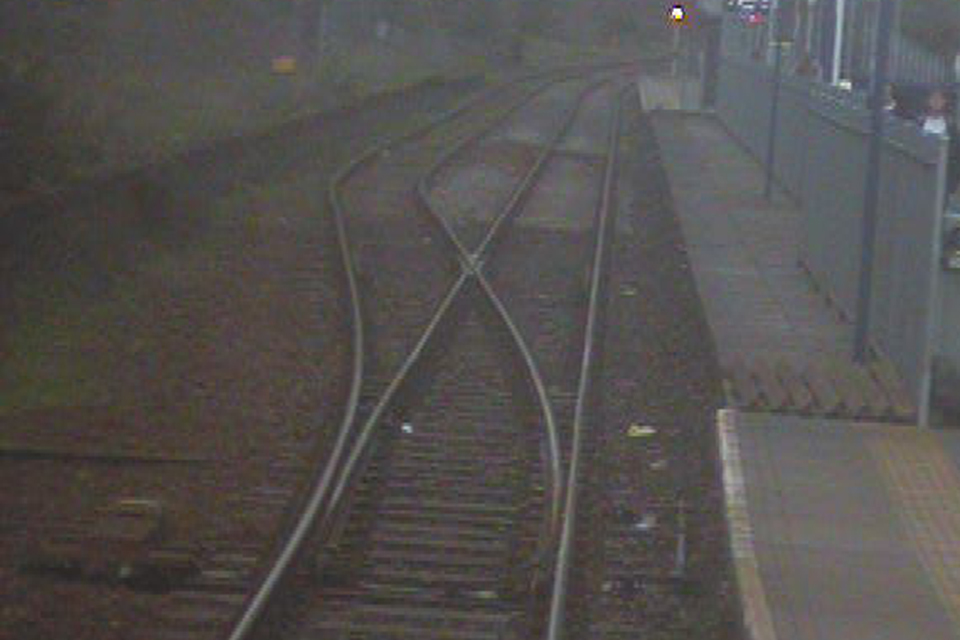Passenger train derailment at Penryn, 28 January 2019
Published 11 April 2019
1. Important safety messages
This accident demonstrates the importance of the following safety learning:
- When degraded working arrangements are in operation, the protection normally provided by the interlocking may be wholly or partly absent. In these circumstances, signallers need to ensure that a route is correctly set before giving permission for a train to pass over it
- This derailment acts as a reminder to signallers that should a colour light signal fail to clear, the fact that it is possible to reverse the associated lever should never be interpreted as proof that all points in the route ahead are correctly set and locked
- Drivers of trains are reminded that in accordance with the rule book they must, when authorised to pass a signal at danger, prepare themselves on the approach to points, observe the maximum speed of 15 mph and where possible look at the position of the points (Rule Book module S5 section 4)
These three learning points were first published in the RAIB’s report on the derailment of a passenger train at Knaresborough, Yorkshire, on 7 November 2015. (RAIB report 16/2016)
2. Summary of the accident
At around 12:30 hrs, train 2T76, the 12:20 hrs service from Falmouth to Truro, was entering the station at Penryn, Cornwall, when the first bogie of the leading coach became derailed while the train was travelling at about 16 mph (26 km/h). The train, which was formed of a two-coach diesel multiple unit, was passing over a set of facing points at the time, and it came to a stop with the leading coach straddling both routes. The 14 passengers on the train were able to alight onto the station platform, and continued their journeys by road.
No-one was hurt, and there was only minor damage to the train and the track.

Figure 1: Track diagram showing signalling layout. The points are shown in the ‘normal’ position
3. Cause of the derailment
Penryn station (figure 1) is the intermediate passing point on the single track Falmouth branch line. The passing loop was constructed in 2009, for the introduction of a half-hourly service on the line. A single platform serves trains travelling in both directions, and loop points 27 are located near the centre of the platform, so that trains travelling towards Truro can enter the station before being passed by trains going in the opposite direction, which call at the Falmouth end of the platform. The maximum permitted speed for trains passing over the points is 25 mph (40 km/h).
The points and signals at Penryn are controlled remotely from the mechanical lever frame in the signal box at Truro. Interlocking between the levers is intended to prevent the setting of conflicting routes, and electrical switches linked to the levers send commands to the points and signals. On 28 January, the signaller at Truro found that, when he tried to set the route for train 2T76, he was unable to clear signal T9, which controls entry to Penryn station in the up direction, although he was able to operate the lever which controls it. When the train arrived at signal T9, the signaller contacted the driver by radio and authorised him to pass the signal at ‘danger’ (red).
The train driver repeated back the instructions that the signaller had given him, and drove the train towards the station. Points 27 were not in the correct position, and the leading wheels of the train passed either side of the switch rails, leading to immediate derailment (figures 2 and 3).

Figure 2: The derailed train 2T76

Figure 3: The front of train 2T76 at Penryn station
The driver reported that he was concentrating on controlling the speed of the train as it entered the station, and did not observe that the points were not in the correct position (figure 4). Evidence from the forward-facing CCTV fitted to the train shows that the points were lying in mid-position as the train approached.

Figure 4: Forward Facing CCTV image from train 2T76 showing points 27 lying in the mid- position at Penryn station
There is an indicator for points 27 in Truro signal box, which shows whether the points are detected in the normal or reverse positions, or are not detected and therefore should be assumed to be in some intermediate position. The signaller at Truro believed that this indicator was showing the normal position when he told the train driver to pass the signal at danger. As the train passed over the points and derailed, the points moved back from the intermediate position to the normal position, and after the accident the indicator in the signal box was found to be showing that the points were detected in the normal position.
After the accident, Network Rail carried out a technical investigation. Records from the data logger fitted to the installation showed that points 27 had been operated to the normal position about fifteen minutes before the accident, and were detected in this position, but a few seconds later moved, uncommanded, to an intermediate position, causing detection to be lost. At the time the points moved, the signal lever was normal in the frame.
The lever for signal T9 is mechanically locked with the lever for points 27 but there is no electric locking associated with the points detection. Lever 9 can be operated as long as lever 27 is in the normal position and other interlocking conditions are met, but signal T9 will not clear without points 27 being detected normal and indicated as such.
Investigation and testing was undertaken on the detection circuits at Penryn associated with points 27, the time division multiplex transmission to Truro signal box, the points indication circuits and the electrical and mechanical interlocking, with no evidence of a fault or wrong side failure being found.
Signalling failure investigation was also carried out on the electrical cables and the point machine at Penryn. These tests found very low insulation resistance values between some of the cable cores, and in the points motor itself.
Network Rail’s technical investigation was still in progress at the time of publication of this digest. Initial indications are that the points machine was energised, and consequently moved the points, when no command was present, although the testers were unable to recreate conditions that may have led to this. The faults that were found were not associated with the indication circuits to Truro signal box.
The point motor and cables were replaced. As a precautionary measure, various relays and contacts at Truro signal box were also replaced, although no faults had been found with them.
4. Previous similar occurrences
RAIB report 16/2016 describes a derailment at Knaresborough, Yorkshire on 7 November 2015 which occurred in similar circumstances. Three learning points from that investigation have been repeated in this safety digest.

